

|
|
Tweet |

The original version is also online!
The techniques described in this article apply to wheels of conventional construction, generally with 28 or more evenly-spaced spokes.
At the time Sheldon wrote the article, most wheels were less precisely built than today, and most bicycles had steel rims. The first common, well-engineered aluminum alloy clincher rim, the Super Champion/Wolber Model 58, with parallel sidewalls and a pinned joint, had only been on the market for a few years, and was a relatively high-end product. I learned precise wheel truing on Fiamme and Weinmann aluminum rims which had angled sidewalls, such that even a small amount of out-of-roundness caused rim brakes to work unevenly. Braking was uneven at the rim joint as well: it was welded and then ground down to remove excess material -- usually ground down too far. Most bicyclists accepted these conditions as normal.
Today, precise, extruded, aluminum-alloy rims are usual except on cheap bicycles. Truing a wheel that has only a slight wobble is as valid as ever, and so is replacement of a broken spoke. Rougher techniques can often get a seriously damaged wheel into good enough shape to ride home, or to the nearest bike shop. These techniques cannot nearly as often be expected to make a wheel as good as new, because new is so much better than it used to be. An as-good-as-new repair generally requires replacing the rim. There is another article on this site about on-road wheel repair using improvised tools and techniques.
One additional warning: The techniques described here are not very applicable to "boutique" wheels with low spoke counts, unevenly-spaced spokes and rigid, deep-section rims, whether of aluminum or carbon fiber. These wheels do not as easily go out of true, but they are fragile in other ways and often cannot be made rideable if damaged. They are expensive, too, a clear case of paying more for less!
Other rims can often be repaired, though as Sheldon says both in this article and in his wheelbuilding article, repairing a damaged wheel is much more difficult than rebuilding a wheel with a new rim. And it is possible to transfer spokes from a damaged rim to a new one, making for a quicker repair. Practice in building new wheels helps build the technique to repair damaged ones. -- John Allen
Of all the maintenance and repair jobs that may be needed on a bicycle, the trickiest is truing (straightening) wheels. A good wheelbuilder, in many cases, can do amazing things for a wheel that might appear to be totally destroyed. But a person who tries to "touch up" a slightly out-of true wheel without proper knowledge could turn an imperfection into a disaster. If you have a badly damaged wheel of basically good quality, take it to a good wheelbuilder. If you want to learn to repair wheels yourself, the best approach is to start by building and truing new wheels, using new spokes and new rims. It is much easier to master the fundamentals working with undamaged parts.
To build a wheel from scratch, see my Wheelbuilding article, also on this site.
This is not to say that there is nothing a cyclist with reasonable mechanical skills can do in cases of moderate damage. But I would suggest that you not mess with your spokes unless you have mastered most other aspects of bicycle maintenance.
Let's assume that we have an out-of-true wheel to deal with. The rim may be hitting one or both of the brake shoes during its rotation, or it may just be coming close.
![]()
![]()
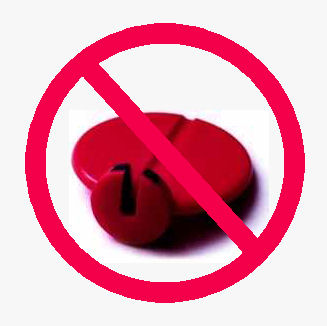
Usually, the rim is damaged, and there is no damage to the spoking. If you do not adjust the spokes, they will help guide you in restoring the rim.
There are a couple of exceptions.
The first step in repairing a wheel is to check the condition of the rim itself. If the rim sidewall has a blip (bulge), no amount of spoke adjustment will help the problem. A rim brake will catch on the spread-out part of the rim. This will cause dangerously uneven braking, and possibly may even cause the wheel to lock up under hard braking. It also will cause a bald spot on the part of your tire tread that is in contact with the road when the blip reaches the brake.
Blips may or may not be accompanied by flat spots or dents (where a portion of the rim has been pushed in toward the hub, making the wheel out of round). If there is such a flat spot more than 2 or 3 millimeters deep, the wheel should first be taken to a well-equipped bike shop which has a special tool for pulling out dents of this sort. The puller is only for rough adjustment, and fine tuning with the spokes still will be necessary.
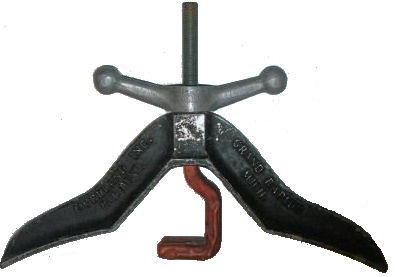 Now, if you want to pull out dents...here are some ways.
Now, if you want to pull out dents...here are some ways.
I own an Overland Rim-True Straightener, probably the tool Sheldon mentioned (photo at right). It has a concave shoe which sits on top of the inflated tire, and a hook which goes under the rim. The bottom of the hook is forked so it can fit over a spoke. Tightening a large wingnut pulls the hook up, and pulls out the dent in the rim. This tool is no longer made, though it sometimes appears on eBay.
The rim must be low-profile, not deep-section, which is much more rigid and will suffer worse damage to the flange(s) if damaged at all.
The next set of instructions is for a rim which is bent inwards. Repairing splayed flanges is much more troublesome. Instructions are later in this article, but don't expect to get the rim good enough that a rim brake works evenly.
If the spokes have not been adjusted since the wheel was damaged, they can provide a good guide as to how far to pull out the rim. Loosen the spokes at the center of the dent about 6 turns, tapering off over a couple of spokes to either side. (But remember, turning spokes when the tire is inflated can puncture the inner tube if the rim does not have recessed spoke holes -- so you should deflate the tire at this step). Reinflate the tire before you pull out the dent. Remove the tool, deflate the tire, 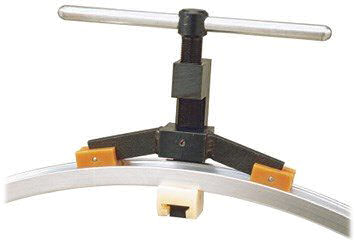 retighten the spokes and check the true of the rim. You can check without removing the tire, by sighting across the inner face of the rim while the bicycle is on the truing stand or the bicycle. You may have to pull out the dent again, with the spokes loosened a couple of turns further. You are done when the retightened spokes come up to the same tension as the other spokes, and the dent is gone. For the final truing, remove the tire so you can guide accurately on the outside of the rim.
The result isn't absolutely perfect but it is functionally fine. It's quite a bit of trouble. It was worth the trouble for me with one flat spot on a friend's special, hand-built wheel.
retighten the spokes and check the true of the rim. You can check without removing the tire, by sighting across the inner face of the rim while the bicycle is on the truing stand or the bicycle. You may have to pull out the dent again, with the spokes loosened a couple of turns further. You are done when the retightened spokes come up to the same tension as the other spokes, and the dent is gone. For the final truing, remove the tire so you can guide accurately on the outside of the rim.
The result isn't absolutely perfect but it is functionally fine. It's quite a bit of trouble. It was worth the trouble for me with one flat spot on a friend's special, hand-built wheel.
As of 2019. Cyclus, in Germany, is making a similar tool (photo at left) designed for use without the tire mounted on the rim. I have no experience with it. From the photo, it appears not to allow placement directly over a spoke, and so that spoke can't be used to measure the amount that the rim has been pulled out. The photo, from the manufacturer, shows a rim without spokes 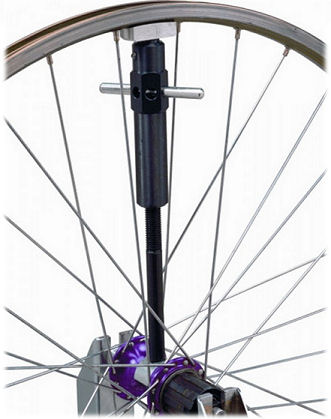 -- which would make it impossible to review work using a truing stand or with the wheel installed on the bicycle.
-- which would make it impossible to review work using a truing stand or with the wheel installed on the bicycle.
A video on YouTube shows straightening using wooden blocks in a bench vise, requiring removing many spokes. Leaving the spokes in and using them to guide the work saves a lot of time.
An alternate tool is the "rim stick" -- a telescoping, threaded assembly with a pad at one end to rest against the hub barrel, and at the other end to rest against the rim. Cyclus makes one of these as well. This could be built as a do-it-yourself project. Whether the tool comes with pads to fit different-diameter hub shells, I don't know. An attempt to straighten a rigid rim could dent the hub shell instead.
Blip removal, which Sheldon describes below, is also possible with improvised tools; as described in the article about on-road wheel repair.
Now that the wheel is reasonably round, you are ready to deal with the blip itself. Some bike shops have a special pair of pliers made for this purpose. There is also a tool called the Rim Rench, currently out of production, but it may be back in production by the time you read this. If you don't have the special pliers, the best tool is a hammer. The rim should be rested on a corner of a workbench so the side you are not hitting is supported over a fairly wide area that centers on the blip. The hammer can remove only outward bends; the other tools can remove inward bends too..
The blip can be located most easily by holding the wheel under a light 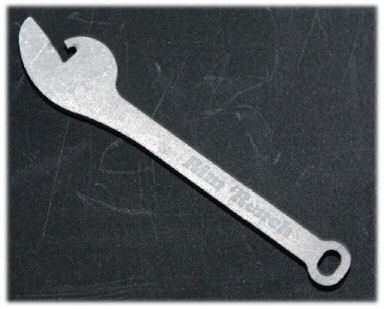 and looking at the reflection of the light as you rock the wheel back and forth. The blip will show up clearly as the reflection passes over it.
and looking at the reflection of the light as you rock the wheel back and forth. The blip will show up clearly as the reflection passes over it.
When you hit the rim, aim your swing so that the face of the hammer will be parallel to the angle of the undamaged portion of the rim.
The greatest danger, no matter what kind of tool you use, is overcorrecting and then denting in the side of the rim. To keep this from happening, apply just a little bit of force at first, check the reflection again, apply just a little bit more force, check and so on. It doesn't take as much as you might think.
It is a good idea to leave the tire on the rim and fully inflated for this operation. Don't try to straighten one side completely first and then start on the other. Instead, start on the worse side, work on it until it is better than the other side, then change sides. Keep on the same way, working on first one side, then the other, whichever is worse at the time. Don't be in a hurry.
![]()
![]()
Once the rim is free from blips and serious flat spots, check the tension of the spokes. Put your thumb around one spoke and your fingers around the spoke next to it and squeeze. The spokes should feel tight and firm. They should have just a little give when you squeeze them fairly hard. Repeat this process with the next pair of spokes and so on until you have worked all the way around the wheel and felt every spoke. Squeeze a few spokes on other bikes to get an idea of how they should feel. It is rare for spokes to be too tight, but it is very common for them to be too loose. It is normal for the spokes on the left side of the rear wheel to be looser than the others.
If all of your spokes are too loose, first take off the tire, tube and rim tape. It may be helpful to put a little bit of light oil on the spoke nipples. Starting at the valve hole, work your way around the rim, tightening each spoke exactly the same amount. Stop when you get back to the valve hole so that you will know that you have tightened each spoke once and none of them twice.
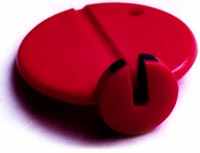 I recommend working in half-turn increments at most. Tighten all of the spokes one-half turn and then check the tension again. If all of the spokes are still too loose, repeat the process. If you get three quarters of the way around the wheel and have trouble turning the nipples, you have gone too far. In this case, you must loosen up the spokes you have tightened, working right back to the valve hole. It is very important not to lose your place. If you do not tighten every spoke the same amount, you will throw the wheel out of true. The limiting factor for spoke tension in most cases is how tight you can get them without stripping the nipples. [This was the case with poor-quality spokes in the 1970s, especially if they were not lubricated. High-quality spokes can often be tensioned so much that the rim gives way. See Sheldon's wheelbuilding article -- John Allen]
I recommend working in half-turn increments at most. Tighten all of the spokes one-half turn and then check the tension again. If all of the spokes are still too loose, repeat the process. If you get three quarters of the way around the wheel and have trouble turning the nipples, you have gone too far. In this case, you must loosen up the spokes you have tightened, working right back to the valve hole. It is very important not to lose your place. If you do not tighten every spoke the same amount, you will throw the wheel out of true. The limiting factor for spoke tension in most cases is how tight you can get them without stripping the nipples. [This was the case with poor-quality spokes in the 1970s, especially if they were not lubricated. High-quality spokes can often be tensioned so much that the rim gives way. See Sheldon's wheelbuilding article -- John Allen]
If all but a few of your spokes are mostly tight enough, the worst mistake you could make would be to tighten just the loose spokes. It is possible for spoke nipples to loosen up on their own, especially in wheels that were built with insufficient tension to begin with, but this is rare. Usually when just one or a few spokes are loose, it is because the rim has been bent to ease their tension. In this situation, tightening just the loose spokes will cause the wheel to bend even more, in the same direction. Instead, the rim should be bent back into shape first. Repair of inward dents has already been described. But also, a wheel can go out of true (so the rim weaves from side to side as it turns) one of two ways. The rim itself can be deformed, usually by hitting a bump, or the problem may be caused by spokes' being broken or out of adjustment.
Checking the spoke tension will reveal any broken spokes. If spokes are broken, they must be replaced and adjusted before any other spokes are adjusted. Get the wheel as true as possible by adjusting just the spoke(s) you have replaced. Then you may still have to do a little bit of touch-up adjustment on adjacent spokes. If there are no broken spokes, but you have reason to believe that some of them have vibrated loose, that is a job for an experienced wheelbuilder who can true for roundness as well as for side-to-side variations.
In most wheels where the rim weaves from side to side, the problem is the result of the rim's being bent. Remove the tire, tube and rim tape if you didn't already. If a truing stand is available, use it. If not, your bicycle will do. Hang or otherwise support the bicycle so that the wheels can turn freely, with the brakes at a convenient working height. If you are working on the rear wheel, it will make things easier to remove it from the frame and reinstall it so that the chain is not touching the freewheel sprockets.
Remove your brake shoes and reverse them so that the rubber faces away from the rim and the nut that holds the shoe on is toward the rim. Slightly loosen the brake center bolt so that you can push the brake back and forth to bring the nuts on the brake shoes in contact with the rim. These nuts will serve as the feelers on a truing stand. [It is not really necessary to reverse the brake shoes; you may also use them as feelers, as described in the wheelbuilding article The photo below also shows a small ruler placed across the rim to test for out-of-roundness. A pencil or a spoke also can serve this purpose -- John Allen]
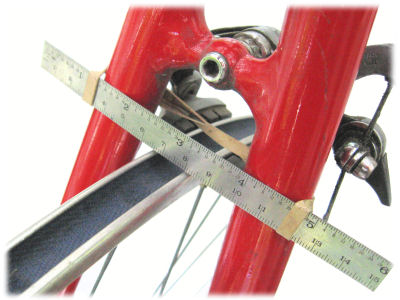
Spin the wheel and look to see where the worst bend is-the place where the rim is farthest from its average position. Which side is it bent toward? Let's assume that it is bent to the right in one area, and that this is the most severe bend on the rim. Move the right-hand brake shoe in toward the spinning rim until it just rubs at one point in the wheel's rotation. Feel the tension on the spokes in the immediate area of the bend.
If the spokes that go to the right flange of the hub are loose and the ones that go to the left are tight, that is the result of the rim's being deformed. Since the rim has been pushed over to the right, it eases the tension on the right spokes while increasing the tension on the left spokes. If you just tighten the left spokes in the area of the bend, it will pull the rim back toward the middle, but it also will create a flat spot. Even if you are able to get the wheel true this way it will be seriously weakened because the spoke tension will be uneven.
The proper repair in this situation is first to bend the rim back to its normal shape, and then fine-true it with the spokes. Lightweight wheels can be bent fairly easily by placing your knee or foot right on the peak of the bend, and pulling with your hands on either side of the bend. This or a similar technique should be used whenever a rim is bent more than 1 centimeter to the side and there are no broken spokes. Even wheels that have collapsed into the shape of a potato chip usually can be made rideable again with this technique This is a very useful on-the-road repair -- it even can be done without removing the wheel from the bike. If you are not sure of your skill, you are less likely to do further damage bending wheels over your knee, spectacular as it may look, than with a spoke wrench used carelessly.
[Also see other techniques to straighten a bent wheel, in the article about on-road wheel repairs. A "potato chip" wheel will often pop back nearly into its original shape. The photo below illustrates a technique described in that article -- John Allen]
If the rim is bent to the right, and the right-side spokes are tighter than the left-side spokes in the area of the bend, or if the tensions are about equal, the spokes are the cause (and cure) of the trouble. Working only in the immediate area of the bend, tighten the left spokes and loosen the right spokes, keeping the overall tension the same. For instance, if the bend involves four spokes, you might tighten each of the left spokes one-fourth turn and loosen each of the right spokes one-fourth turn. If only three spokes are involved, say two on the left and one on the right, you might tighten each of the left ones one-eighth turn and loosen the one on the right one-fourth turn. By maintaining this balance, you can true the wheel from side to side without making it go out of round. Until you have acquired a lot of experience truing wheels, don't turn any spoke more than one-fourth turn at a time for side-to-side truing.
![]()
![]()
Now that you have made an adjustment to the worst bend to the right, check to see whether you have made it worse or better. If it is worse, you turned the nipples the wrong way, so correct that mistake immediately. If your adjustment has made an improvement, don't worry that it has not completely eliminated the bend. Spin the wheel to see if the bend you worked on is still the worst bend to the right. If it is, adjust it a little more. If it isn't, or you can't be sure, find the worst bend to the left, and work on it. If you keep alternating from one side to the other in this way the wheel will maintain its "dish" or lack of dish. This means that the rim will stay centered between the dropouts.
The spoke is in effect a bolt, and the nipple a nut. They have a standard right-hand thread, but the spoke wrench fits on the underside of the nipple, and so it is very easy to become confused as to which way to turn it. It is like looking at the back side of a clock with a transparent dial-the hands would appear to be going counterclockwise, because of the unusual viewpoint.
The top of the nipple usually has a screwdriver slot cut in it. Normally, you can't use this for truing, because you can't get the nipple tight enough with just a screwdriver. This does, however, serve as a useful guide for judging which way to turn. Imagine you were going to use a screwdriver to tighten a nipple. You would turn it clockwise. Now use the spoke wrench and make the nipple turn the same way. If you look at it from the direction of the hub, it will seem that you are turning it counterclockwise. Anytime you are unsure which way to turn a nipple, don't turn it at all until you are sure, or you will just make matters worse.
When the spokes are tight, and especially if the threads have not been oiled, turning the nipple may just twist the spoke at first instead of moving the nipple along the spoke threads. For instance, you may wish to tighten a particular spoke one-fourth turn. What might very well happen is that for the first one-eighth turn the spoke may twist and then the threads may yield and turn one-eighth turn. You turn the nipple one-fourth turn, but the threads only tighten one-eighth turn and the spoke will have an one-eighth-turn twist. Eventually the twist will work itself out by completing the screwing action in the nipple, and when it does the wheel will go out of true. The easiest way to deal with this problem is to tighten the nipple a three eighths turn and then loosen it one-eighth back, so the net result is one-fourth turn and the spoke will not be twisted. The amount that a spoke will twist will vary from one spoke to another, but with practice and sensitivity you can feel when you are twisting a spoke and when you are untwisting it.
After the wheel has been trued, look on the inside of the rim and check to see whether any spoke ends are protruding above the tops of the nipples. If so, unless the rim has recessed spoke holes, you must file the spoke ends down flush or they will puncture your inner tube. If you have used oil on the nipples, make sure to get it off the rim inside and out. Oil on your rims will rot your tires and make your brakes grab.
Don't be in a hurry for this job. Speed comes only after a great deal of practice. Take your time, and if you find yourself getting frustrated, stop. Go away and relax, do something else for a few hours and come back to it when you are fresh.
![]()
![]()
![]()
Last Updated: by John Allen